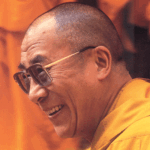| The following article is from the Spring, 2003 issue of the Snow Lion Newsletter and is for historical reference only. You can see this in context of the original newsletter here. |
BY AVERY SOLOMON
Every year or two since 1987, several top western scientists meet for a week with His Holiness the Dalai Lama, other Buddhist Lamas, and observers to have a dialogue between Buddhism and Science. This year, the focus topic was the nature and origin of life. Several monks from the Science/Math for Monks Program with whom I have been working were invited to the conference. By good fortune, I was able to attend.
In October, the weather in Dharamsala is about as nice as it gets. We met every day for five days in the quarters of His Holiness the Dalai Lama On the first day, we were searched before entering the private compound of several acres. Present in the colorful private quarters were 18-year-old incarnate lama Karmapa, five western scientists, two translators, a Western lama, a western philosopher, and the organizer Adam Engle, sitting around on comfortable .chairs and couches. Around the outside were observers. On one side, there were about 20 Buddhist monks and lamas, translators from LTWA, and people from the math/science program. On the other side were former participants in the conferences, families of the current presenters, and several others including Richard Gere and Goldie Hawn.
Each morning, for about 2 1/2 hours, one of the scientists presented the cutting edge of science, on the theme of what is life, how does it evolve, and where does it come from. Each afternoon for two hours there was a dialogue on questions raised in the morning, or directed to His Holiness for response.
His Holiness and the lamas addressed many ethical issues of stem cell research, genetic engineering, and so on. At what point in the embryo development can we definitely say the embryo will be human? Cells divide identically up to about 64 cell mass. Then, subtle variations in environment, such as heat, proximity to the center or outside of the mass, etc., induces certain of these cells to throw a switch which causes certain proteins to be produced, which takes the cells down the path of differentiation. From there on the characteristics of being a human form emerge more and more. So is that the point at which taking the life would be unethical? Many times, His Holiness brought up the suggestion that the motivation for the research must be questioned. Science is neutral, but how we make use of it, and why we are doing it is important. There was a discussion of the role of sentient beings and karma. Where does karma begin to affect the changes in the genes? How do sentient being plugs in to the natural order of the universe?
There was a brief but beautiful presentation of the Buddhist view of emotions and ethics. Can consciousness be a separate principle from matter? His Holiness brought it back to the ethical point: whether consciousness comes from matter or not, how will we live our lives is the important question.

Can consciousness be a separate principle from matter? His Holiness brought it back to the ethical point whether consciousness comes from matter or not, how will we live our lives is the important question.
During the meals, we all ate together, and there were many inspiring conversations and new friendships. Some germinal ideas floated around about a venture to interrelate mathematics and Buddhism, studying foundational ideas about proof and understanding in Buddhism, science and mathematics. I left with a renewed sense of the way our Earth has become more of a one-world. Centuries-old Buddhist tradition met centuries-old scientific tradition, and there was real listening and dialogue.
For more information on the Mind and Life Conferences: www.mindandlife.org

